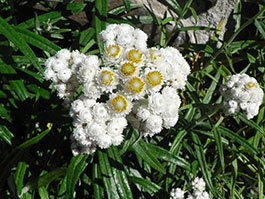Pearly Everlasting in the Landscape

Aaron Anderson, Oregon State University
Scientfic Name: Anaphalis margaritaceaCommon Name: Pearly Everlasting
Description: Pearly everlasting is an easy to grow, herbaceous perennial. Growing from stolons, it is both spreading and erect when in bloom, with mature plants reaching up to 24” tall. Its leaves long and thin (1/4”) and are a green-grey color with downy hairs. Pearly everlasting flowers are small and yellow, and surrounded by papery white bracts. These small flowers are clustered in a terminal inflorescence. Depending on the environment, this species will bloom from early summer through fall. It is relatively drought tolerant, and does not need supplemental irrigation in the summer once established.
Native Habitat: Anaphalis margaritacea is native throughout United States (except for the southeast) and is found in all Western and Rocky Mountain states. Found in dry open meadows and upland prairies, from sea-level to subalpine elevations. Grows well in sandy, gravelly, or clay soils. Larval host plant for the American Painted Lady butterfly (Vanessa virginensis).
Cultural Requirement
Soil: Grows in sandy and gravelly soil with optimum pH between 5.2 and 6.6. Will also tolerate clay soils. Tolerates nutrient poor soils.
Moisture Tolerance: Low water requirement, irrigate a maximum of twice a month in the summer. Grows well in slightly moist to very dry soils.
Sun/Shade/Preference: Prefers full sun but will grow in partial shade.
Transplanting: Grows well after transplanting, and can even be grown from cuttings. Be sure to plant deep enough to prevent “frost heaving” during the first winter.
Propagation: Can be grown from seed harvested in the field. Seeds require no pre-planting stratification. Sow into a firm bed with a lightly raked surface to improve germination. Plants will emerge in about three weeks and will need light irrigation to keep from drying out (though over-watering can lead to damping-off). After about six weeks, plants will be better established and need less water. Pearly everlasting can also be propagated in the spring by cuttings or dividing the root mass and replanting.
Maintenance (pruning, fertilization, deadheading, division, irrigation, etc):
Insect, disease, or other problems: Seedlings can be prone to damping-off if overwatered. As it is a butterfly host plant, some herbivory by caterpillars can occur.
Landscape Value
Use in the Landscape: Pearly everlasting is ideal for use in butterfly gardens because it is used as a larval food source by Vanessa virginiensis and provides floral resources to other pollinators. This species can add texture and color to wildflower gardens and rock gardens. Because it is drought tolerant, Anaphalis margaritacea works well in borders that are not regularly irrigated.
Weediness/Invasive Potential: Pearly everlasting grows via rhizomes and can spread vigorously under good conditions.
Foliage: The leaves are narrow, alternate, and found along the entire stem. When large, with multiple stems, the foliage can appear bushy. Deciduous.
Flower: The flowers are small and yellow disc or ray composites, surrounded by layers of papery white bracts that make them look “pearly”. Pearly everlasting is dioecious, meaning plants consist of entirely male or female flowers. The white bracts are long lasting and maintain pearly everlasting’s aesthetic appeal long after bloom ceases.
Timing: Early Summer – Fall
Fruit: The fruit is a very small achene (~1mm long), with hairs on the end.
Form: Erect stems.
Texture: Moderately fine.
Ultimate Size: Plants can reach 24” tall when mature, but plants will flower at much smaller sizes.
Rate of Growth: Grows relatively quickly and will flower in the first year of growth.
Suggested Plant Partners: Will work well with native grasses and other native wildflowers, including woodland and meadow natives such as Geranium viscosissimum, Asclepias speciosa, Aquilegia formosa, Potentilla gracilis, and Rudbeckia hirta. If planted for butterfly habitat, consider pairing with other butterfly-friendly flowers.
Availability: Starts are available at some specialty native plant nurseries and at native plant sales. Seed can be purchased from commercial native seed suppliers.
Cultivars: No known cultivars.
References:
Robson, K. A., Richter, A., & Filbert, M. Encyclopedia of Northwest native plants for gardens and landscapes. Timber Press, 2008.
Anaphalis margaritacea, Plant Database. Lady Bird Johnson Wildflower Center, University of Texas, 2012. Accessed Feb. 10, 2018 at https://www.wildflower.org/plants/result.php?id_plant=anma
Pearly Everlasting – Anaphalis margaritacea. California Native Plant Society, 2014. Accessed Feb. 10, 2018 at http://calscape.org/Anaphalis-margaritacea-()
Flessner, T.R..; Trindle, J. Propagation protocol for production of Anaphalis margaritacea (L.) Benth. seeds (seed from seed increase); USDA NRCS - Corvallis Plant Materials Center, Corvallis, Oregon, 2003. Accessed Feb. 10, 2018 at https://www.nrcs.usda.gov/Internet/FSE_PLANTMATERIALS/publications/orpmcmt9963.pdf
Plant Finder – Anaphalis margaritacea. Missouri Botanical Garden. Accessed Feb. 10, 2018 at http://www.missouribotanicalgarden.org/PlantFinder/PlantFinderDetails.aspx?kempercode=j330
